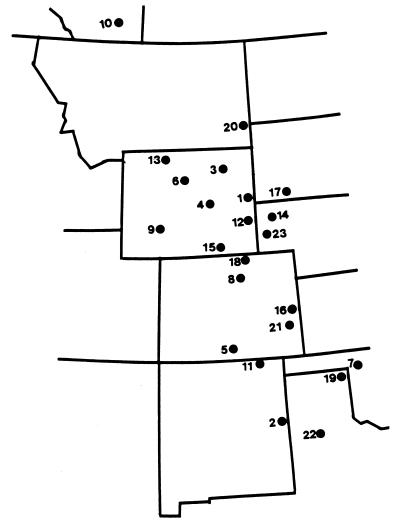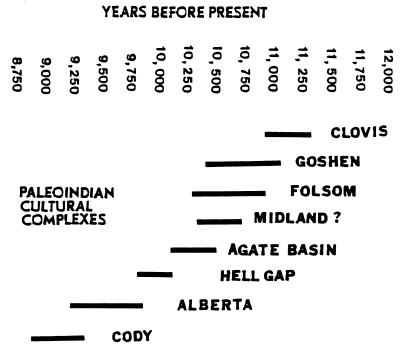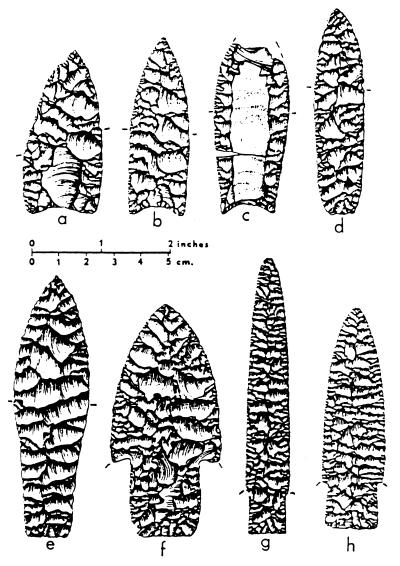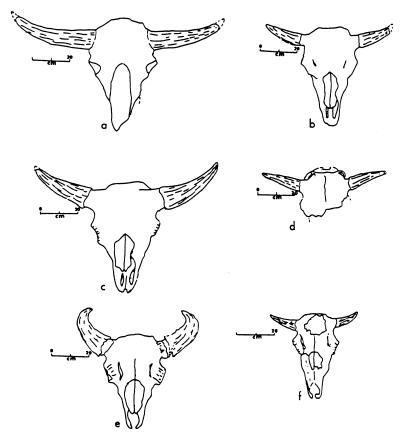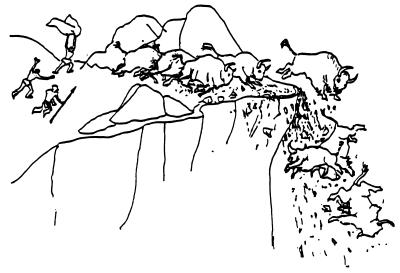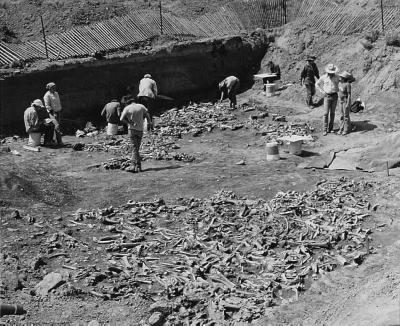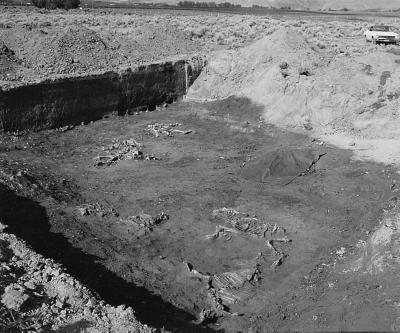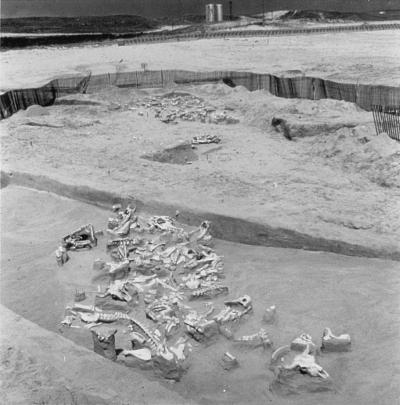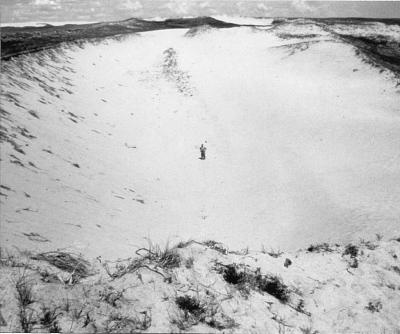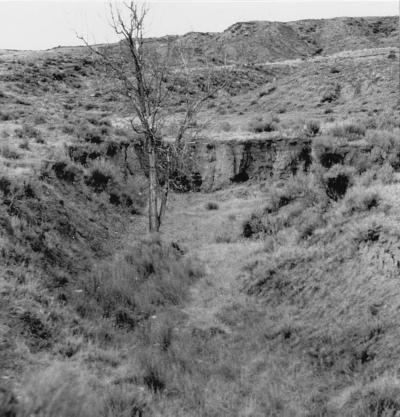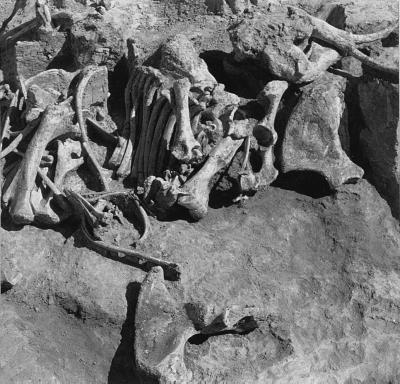Abstract
From ≈11,200 to 8,000 years ago, the Great Plains of North America were populated by small Paleoindian hunting groups with well developed weaponry and the expertise to successfully hunt large mammals, especially mammoths and bison. Mammoths became extinct on the Plains by 11,000 years ago, and, although paleoecological conditions were worsening, their demise may have been hastened by human predation. After this, the main target of the Plains Paleoindian hunters consisted of subspecies of bison, Bison antiquus and Bison occidentalis. As bison populations gradually diminished, apparently because of worsening ecological conditions, by ≈8,000 years ago, human subsistence was forced into a greater dependence on small animal and plant foods. Human paleoecology studies of the Paleoindian time period rely heavily on multidisciplinary efforts. Geomorphologists, botanists, soil scientists, palynologists, biologists, and other specialists aid archaeologists in data recovery and analysis, although, with few exceptions, their contributions are derived from the fringes rather than the mainstream of their disciplines.
The time and circumstances surrounding the arrival of the first human inhabitants of North and South America has become a lively topic for debate (1, 2). However, the Northern Plains and montane basins of the central and southern Rocky Mountains have produced some of the best preserved evidence of North America’s earliest known pedestrian, large mammal hunters whose presence is documented during the closing years of the Pleistocene after ≈11,500 years ago. Other groups, recognized by weaponry and tool assemblages, were present until ≈9,000 years ago. By 11,000 years ago, a number of large mammal species, including the mammoth, mastodon, camel, and horse were extinct or nearly so, and the older subspecies of bison would follow soon after. The search for an explanation of these Pleistocene extinctions has been another lively and controversial topic for paleontologists, biologists, geologists, and numerous other specialists for several decades (3, 4). The debate turns on whether the late Pleistocene extinctions were the results of paleoecological changes, human predation, or a mixture of both. The problem shows no signs of an immediate resolution (5–7).
The confirmation in the 1920s of human presence with an extinct subspecies of bison at the Folsom site in northern New Mexico (8) and the mammoth at the Dent site in Colorado (9) as well as the Blackwater Draw site in eastern New Mexico shortly afterward (10, 11) drew archaeologists into the subject of Pleistocene extinctions. However, they addressed problems differently from most specialists of the Pleistocene and focused mainly on human predator–prey relationships. These included the time of year, location, and geologic features utilized in animal procurement events; butchering and processing; and the amount and distribution of food products, all of which could assist the archaeologist in determining the social and subsistence activities of the human groups involved. At about the same time, archaeologists also realized that a wide range of paleoecological data might provide even more information on prehistoric human subsistence strategies.
Since then, the multidisciplinary approach has been standard procedure in archaeology. This is especially true in studies of the Plains Paleoindian time period, when the cultural groups were small and highly mobile and left behind scanty evidence of their presence, preserved in well stratified geologic contexts only in a few ideal situations. Site visibility, site formation processes, and the integrity of site deposits all became important in attempts to reconstruct some details of Paleoindian lifeways. Archaeologists also realized they could not effectively command knowledge of all of the specialized studies they needed. Consequently, they consulted with specialists in a number of other disciplines, although the information they sought was usually on the fringes rather than in the mainstream of these areas. However, the demand for multidisciplinary data became strong enough to develop specialists such as geoarchaeologists able to establish paleolandforms and evaluate the integrity of cultural materials recovered in geologic deposits (12) and taphonomists who observe modern analogs of carnivore, scavenger, and natural modification of animal carcasses (13) and apply their findings to the Paleoindian situation. Radiocarbon dating—in particular, the more recent accelerator mass spectrometer method in which minute organic samples produce more reliable dates than the older method (14)—has enhanced the Paleoindian chronology greatly. This is especially important in many Paleoindian sites where even small amounts of culturally derived charcoal in reliable contexts are rare. Greater accuracy in bone dating has been developed through isolating individual amino acids, removing contaminates, and dating the results by accelerator mass spectrometry (15).
The High Plains Paleoindian Chronology
Our knowledge of the chronology of Paleoindian hunting groups is based on stratigraphy and radiocarbon dates as well as on morphological and technological changes in weaponry and tool assemblages. The data are recovered in locations of human activity or sites named after a variety of situations, including their geographic locations, land owners, and individuals first credited with their discovery. Four stratified, multicomponent sites, Blackwater Draw in eastern New Mexico (16); Hell Gap in southeast Wyoming (17); Agate Basin in east central Wyoming (18); and Carter/Kerr–McGee in central Wyoming (19), complement each other in establishing and confirming the chronology. There are also numerous other sites with radiocarbon-dated dated components that augment this database (Fig. 1).
Figure 1.
Locations of Paleoindian sites referred to in the text. 1, Agate Basin; 2, Blackwater Draw; 3, Carter–Kerr/McGee; 4, Casper; 5, Cattle Guard; 6, Colby; 7, Cooper; 8, Dent; 9, Finley; 10, Fletcher; 11, Folsom; 12, Hell Gap; 13, Horner; 14, Hudson–Meng; 15, James Allen; 16, Jones–Miller; 17, Lange–Ferguson; 18, Lindenmeier; 19, Lipscomb; 20, Mill Iron; 21, Olsen–Chubbuck; 22, Plainview; 23, Scottsbluff.
Seven cultural complexes—Clovis, Goshen, Folsom, Agate Basin, Hell Gap, Alberta, and Cody, from oldest to youngest—comprise the known Northern Plains Paleoindian cultural groups from ≈11,200 years to 9,000 years before present (Fig. 2) and are identified by the imperishable stone elements of their weaponry (Fig. 3). Clovis is the only one presently known to have confirmed association with mammoth remains and is recognized by a distinctive projectile point (Fig. 3a). Goshen, first recognized at the Hell Gap site in southeast Wyoming (17) and better defined at the Mill Iron site in southeast Montana (20), also is recognized by a distinctive projectile point type (Fig. 3b). It may have been contemporaneous with late Clovis and early Folsom and also may have been a direct precursor of the latter. Folsom, best known from the Lindenmeier site in Colorado (21), added the distinctive flutes to their weaponry (Fig. 3c), which may have had both functional and ritual purposes (22).
Figure 2.
Paleoindian cultural complexes and approximate time periods.
Figure 3.
Paleoindian weaponry diagnostics. (a) Clovis. (b) Goshen. (c) Folsom. (d) Agate Basin. (e) Hell Gap. (f) Alberta. (g) Eden. (h) Scottsbluff.
Overlapping with Folsom is the Agate Basin complex, as defined by the bison kill site of this name in east central Wyoming (18). It is identified by a projectile point very different but apparently every bit as lethal as the preceding ones (Fig. 3d). The Hell Gap complex first was recognized at the site with the same name in southeast Wyoming (17) and appears to have developed directly out of the immediately preceding Agate Basin. Several bison kills (23, 24) confirm the expertise of Hell Gap hunters and the efficiency of their weaponry (Fig. 3e).
The Alberta complex introduced different but still efficient weaponry in the form of a stemmed and shouldered projectile point (Fig. 3f). First recognized in southern Alberta, Canada (25), its age and chronological position were confirmed at the Hell Gap site, as were several other Paleoindian complexes (17). A large Alberta bison kill is located in western Nebraska (26), although the procurement strategy involved is not understood clearly.
The Cody complex, named from the Horner site in northwest Wyoming (27), evolved directly out of Alberta. The weaponry is more varied: one part is recognized by the Eden projectile point (Fig. 3g), named after a bison kill site in western Wyoming (28), while the other is recognized by the Scottsbluff projectile point (Fig. 3h), named after a bison kill in western Nebraska (29). An unmistakable diagnostic of the Cody complex is a tool known as the Cody Knife.
After Cody, the archaeological picture on the Northern Plains and Rocky Mountains is unclear and is represented by a number of geographically isolated groups identified by a bewildering array of projectile points, mostly lanceolate in outline form but some with stems and lateral restrictions and nearly all with parallel diagonal pressure flaking patterns. One small bison kill in the Laramie Basin in southern Wyoming contains this type of projectile point (30) and is radiocarbon dated at ≈8,000 years before the present. Most of the evidence between 9,000 and 8,000 years ago indicates a diminishing dependence on bison. After this date and until ≈5,000 years ago, bison become noticeably rare in Northern Plains archaeological sites. Whether this resulted from deteriorating ecological conditions, human predation, or both remains to be learned.
We do know that bison in Paleoindian times were larger and had different skull characteristics (Fig. 4 a and b) than the modern subspecies (Fig. 4 e and f). One important body of data on changes in Northern Plains bison comes from an arroyo kill radiocarbon dated at ≈6,500 years ago in the northeast Wyoming Black Hills with animals intermediate in size (Fig. 4 c and d) between modern bison and those of the late Pleistocene and early Holocene (31). The Black Hills of South Dakota and Wyoming during the period 8,000–5,000 years ago may have served as a refugium for bison while their numbers on the Plains declined. It is possible also that the Paleoindian bison hunting lifeway continued there during this period.
Figure 4.
Male (a) and female (b) B. antiquus skulls; male (c) and female (d) 6,500-year-old intermediate type bison skulls; male (e) and female (f) Bison bison skulls.
The Paleoindian chronology is not all straightforward. Some archaeologists, especially those studying the Southern Plains, think that Midland (Fig. 2) is a separate complex after Folsom while others maintain it is part of Folsom. However, an ongoing reanalysis of the Hell Gap site data suggests strongly that Goshen and Folsom were partially contemporaneous and that the site component identified there as Midland was a Goshen occupation after Folsom. Only recently, with the investigation of the Mill Iron site in Montana (20), have enough new data been recovered to better define the still poorly understood Goshen complex and its relationships with both Midland and Folsom.
Goshen presents still another problem because the projectile points are inseparable technologically and morphologically from those of the Plainview complex, named after a bison kill on the Southern Plains believed to be post-Folsom in age (32). One possibility is that the Goshen complex developed in the Northern Plains and subsequently shifted to the Southern Plains.
Additionally, there are assemblages some archaeologists, regard as transitional between complexes. One example is a 10,000-year-old bison bonebed at the Horner site (27) in which the diagnostics demonstrate technological attributes of both Alberta and Cody (33). To cloud the issue further, some researchers consider the years from 9,000 to 8,000 years ago a part of the Paleoindian period while others assign it to the later Archaic period, when human subsistence strategies demonstrate a lessening dependence on bison and more on plant and other animal resources.
Faunal Studies
The analysis and interpretation of faunal remains from archaeological sites has become a major source of information on past human subsistence strategies. In the 1960s, archaeologists began to study carefully the discarded skeletal remains of animals utilized for food by humans and realized their potential for revealing information on the cultural activities involved (34). Sites where the faunal materials were preserved in geologic deposits with soil conditions not destructive to bone and where the bones themselves underwent a minimum of disturbance from natural causes after being discarded by the human groups involved were especially productive. Many of the principles of paleontologists’ taphonomy (35) provided archaeologists the means to develop a methodology revealing evidence of the events, human and otherwise, that affected the faunal remains between the time the animals were part of a living population and the time they were exhumed by the investigator. This kind of information has been particularly valuable in the analysis of the skeletal remains from communal kills in which large numbers of animals were taken at one time.
However, not all large animal bonebeds resulted from human kills: for example, stream activity transported some to their current locations while others resulted from die-offs of animals weakened by severe winter conditions, floods, and other natural catastrophes. Human weaponry and tools usually provide unequivocal evidence of human involvement, but separating human modification of bone from that of animals and natural forces is often problematical.
Prehistoric Hunting
Although taphonomic analysis of archaeological bone beds offers useful information, it tells very little about the actual animal procurement strategies involved. In addition, few researchers have had enough direct contact with animals to have acquired the expertise needed to predictably procure enough large animal resources to feed a family. Animal procurement requires a body of knowledge that comes only with long-term involvement in predator–prey relationships and familiarity with animal behavior under all conditions and at all seasons of the year.
The factors that control the success or failure of any animal procurement event are complex and ever-changing. Every animal species and individuals within the species demonstrate unique behavioral characteristics depending on internal conditions of sex, age, and animal condition and on external conditions of time of year, weather, topographic features, and vegetative cover. Most of these conditions can and often do change rapidly: for example, a decrease in rainfall and/or deep winter snow affects the availability of grasses, which subsequently affects the location of the animals and ultimately determines the optimum procurement strategy (36).
Lacking reliable accounts of animal procurement, archaeologists have relied on artists’ renditions of hunting episodes that too often violate many rules of intelligent hunting and consequently result in erroneous impressions of predator–prey relationships. Large mammals (mammoths, mastodons, and bison) usually are portrayed mired in bogs with the hunters throwing spears and rocks, dogs barking, and crippled and dead hunters being dragged from the scene (37). Hunters wave blankets at a small group of bison (Fig. 5) and they jump off a cliff to their deaths (38, 39). In reality, bison are extremely agile and, to force them over precipices, a large herd must be stampeded in the proper direction so that the ones in the rear can push the leaders over the edge. Human encounters with bear are often depicted as something akin to wrestling matches rather than life and death contests. In reality once more, a grizzly bear reacts with almost incredible speed and has the strength to break the neck of a juvenile bison or elk with one swipe of a paw. These artistic portrayals of prehistoric hunting have too often left inaccurate and false impressions, which then foster erroneous interpretations.
Figure 5.
Artist’s misconception of bison jumping.
In reality once again, elephants (and presumably, in the past, mammoths and mastodons) and bison spend a large share of their time in bogs and swamps, and unless crippled, aged, or sick, they can extricate themselves at will. Additionally, it would be a nearly impossible task either to extricate or butcher a large animal mired in a bog. A better strategy, and one well within the capacity of Paleoindian hunters, would have been to drive the animal out of the bog and dispatch it on dry land.
Paleoindian Weaponry
The Northern Plains Paleoindian hunting groups developed highly efficient weaponry systems using the best of available raw materials, some from local sources (a few hours’ or a day’s trip) to others at distances up to several hundred kilometers. Clovis is the only Paleoindian complex unequivocally associated with mammoth (40), and this complex designed a projectile point (Fig. 3a) that would both withstand the shock of penetrating the thick mammoth hide and produce lethal wounds. The often raised question, whether a Clovis point would kill a mammoth, led to experiments with dead circus elephants (41) and with replicas of Clovis points on thrusting spear and atlatl and dart delivery systems on dead and dying elephants in the recent culling of elephants in Zimbabwe (42). The results of the latter leave little doubt that Clovis points would have been lethal to both mammoths and/or mastodons.
Paleoindian groups other than Clovis perfected morphologically and slightly operationally different but equally effective weaponry components. Key elements in all stone projectile points are sharp points and blade edges to open a large enough hole in the hide to allow the point and foreshaft to enter and produce a lethal wound.
Paleoindian Hunting Strategies
With the exception of the mammoth, most species hunted on the Northern Plains and Rocky Mountains in prehistoric times are still present, although current wildlife management has changed their former migration patterns, preferences in the sex and age of animals hunted, and seasonality of procurement. In the case of the bison (43) and the mountain sheep (44), there was a gradual decrease in body size from the late Pleistocene to ≈5,000 years ago, when the present-day forms appeared along with possible minor behavioral changes.
Mammoth Hunting.
No modern analog exists that could be claimed unequivocally as a behavioral model for mammoths or mastodons. The Asian elephant is the closest to the mammoth physiologically, but African elephants are better studied as well as more plentiful and available for observation in the wild. Fortunately, preserved mammoths and mammoth parts recovered from frozen deposits (45) provide good evidence of their physiology. Whether or not the matriarchal structure of mammoth and mastodon families was the same or similar to that of African elephants is not known, which is a critical issue in attempts to reconstruct Clovis hunting strategies.
The matriarch elephant provides a strong measure of protection, and any threat to a member of her family brings an immediate challenge. Indiscriminant killing of animals has not been successful, so now, entire families are taken in modern African elephant culling operations. The matriarch is dispatched instantly with a bullet to the brain from a high-powered firearm. Immediately, her family members, oblivious to all else, crowd around her body seeking protection, and they are easily killed. Although replicas of Clovis weaponry have proven lethal against African elephants, their skull structure prevents a Clovis projectile point using either thrusting spear or atlatl and dart from being delivered with sufficient force to penetrate the brain cavity and produce instant death, thereby effectively ruling out such a hunting strategy.
Elephants have relatively poor eyesight but an acute sense of smell. Provided mammoths were similarly endowed, a more likely hunting strategy would have been for Clovis hunters to monitor a herd closely and carefully and quietly spear an animal far enough away from the matriarch to avoid alerting her. It is critical to be properly positioned to obtain a lethal wound. The ideal location of penetration using Clovis weaponry is the rib cage forward of the diaphragm and high enough to penetrate the lungs. The heart is a bad choice because it is protected by the ribs that widen and flatten distally. The experienced hunter tries to avoid flesh and/or stomach wounds, which nearly always result in time and effort wasted in trailing wounded animals.
Considering the probably 1,500–2,000 kg of meat on a juvenile mammoth, the more opportunistic strategy of stalking a single animal would have served the purpose in terms of meat products better than an improbable confrontational strategy to kill an entire family that, if successful, would have provided more meat products than possibly could have been used or stored. The analysis of the Colby Mammoth kill site in Wyoming suggests an accumulation of individuals killed over a period of time rather than a large group (seven animals) killed at one time (46). The Lange–Ferguson site at South Dakota (47) involved two animals, one mature and the other a juvenile.
Several different strategies for Clovis hunters killing mammoths have been presented (48) and include driving them over a precipice; confronting and killing entire families; and opportunistically selecting individuals. However, the data on all mammoth kill sites are as yet too limited to justify more than rank speculation on procurement strategies.
Bison Hunting.
After the Clovis mammoth hunters, extinct subspecies of bison (Bison antiquus and Bison occidentalis) were the main target of the Paleoindian pedestrian hunters on the Plains of North America. To date, the most visible bonebeds (ref. 49, pp. 158–186) suggest large communal kills, but there were also more numerous single and small group hunting activities.
Features Used in Bison Procurement.
A wide variety of natural and artificial features as well as combinations of both were utilized throughout Paleoindian times to trap and/or otherwise impede bison so they could be killed. These include headcuts in arroyos (18, 19); parabolic sand dunes (23); and stampeding animals into narrow, deep, steep-sided arroyos (34). In many cases, constructing a corral or the addition of artificial barriers to enhance the efficiency of a natural feature is suggested. For example, one component at the Horner site (27) is a bison bone bed with remains of ≈70 animals. They were killed as a group in late fall or early winter in a shallow, low-gradient drainage channel ≈0.5 m in depth (Fig. 6). Evidence supporting this place as the actual kill location consists of nearly complete bison skeletons remaining after removal of unarticulated bones (Fig. 7). An added above-ground wooden corral is suggested, although postholes that would confirm the presence of such a structure are lacking and would not have been necessary for a fence adequate to contain the animals. In addition, digging postholes into the cobble terrace on which the site is located would have been extremely difficult. A wooden corral to contain the animals has been suggested also at the Jones–Miller site in eastern Colorado (24).
Figure 6.
Excavating a 10,000-year-old bison bone bed at the Horner site.
Figure 7.
Nearly complete bison skeletons after removal of unarticulated bones in Fig. 7.
In some cases, mainly because of the loss of too much of the original topography, the procurement strategy is unclear. These include the Mill Iron (20) and Hudson–Meng sites (26) and two Folsom age sites, Stewart’s Cattle Guard in Colorado (50) and Lipscomb in Texas (51). In other cases, enough of the original topography remains to correctly identify the feature used, which is critical in determining the procurement strategy and personnel requirements involved.
Hell Gap bison hunters at the central Wyoming Casper site (23) utilized a long, narrow, steep-sided parabolic sand dune to trap nearly 100 animals in the late fall or early winter (Fig. 8). The skeletal material from this site has provided archaeologists with the best preserved assemblage known for taphonomic and taxonomic study of 10,000-year-old bison in North America. The dune field nearby contains several features that would serve as operationally similar bison traps (Fig. 9).
Figure 8.
Ten-thousand-year-old bison bone bed in the bottom of a parabolic sand dune at the Casper site.
Figure 9.
Leeward view of present-day parabolic sand dune similar to the one originally used to trap bison at the Casper site. Dimensions are ≈30 m wide, 300 m long, and 12 m deep. Maximum slope of sides is ≈35 degrees.
Bison hunters at the Agate Basin site (18) utilized a headcut in an arroyo to impede the animals. Analogs of these headcut features (Fig. 10) can be found regularly in the surrounding site area and in other areas with similar landforms.
Figure 10.
Present-day arroyo headcut forming an ideal analog of a Paleoindian arroyo bison trap. Perpendicular clay wall is ≈4.5 m high.
Seasonality of Bison Procurement.
Bison molar teeth have been a strong source of evidence because they preserve well and have predictive eruption schedules up to the age of maturity (52). The low human food value of mandibles resulted in their discard with molar teeth intact at many sites. A bison bonebed resulting from a large kill nearly always contains some immature animals whose age at time of death can be determined within a month or so by analysis of their tooth eruption stages. Animal ages also reveal whether a bonebed represents a catastrophic (instantaneous kill of several animals) or an attritional (animals killed over a period of time) death assemblage. This same methodology is applicable to all faunal assemblages with regular annual birthing and breeding seasons. Unfortunately, relatively little is yet known about the breeding and birthing of the mastodon and mammoth or the circumstances of their procurement. However, the tusks of both species can yield evidence of age and time of year of death (53).
Other Large Animals Hunted by Paleoindians
Relatively small numbers of pronghorn (Antilocapra americana) were taken (54). Still smaller numbers of camel (Camelops sp.) and horse (Equus sp.) bones are found in Paleoindian sites, but no convincing evidence indicates that either was a significant part of the food supply. Most Pleistocene paleontologists believe the camel was extinct by 11,000 years ago, but there is some evidence to suggest it may have survived for several hundred more years (55). Elk (Cervus canadensis) skeletal remains are rare, but their antlers were used for tool, weaponry, and decorative items. More rare yet is evidence of mountain sheep (Ovis canadensis) and mule deer (Odocoileus hemionus) in Plains Paleoindian sites.
Butchering and Processing of Animal Products
Taphonomic analysis continues into the post-kill aspects of faunal analysis. Bonebeds can yield information on butchering and processing of the animals, but the analyst must also be able to separate human activity from that of carnivores, scavengers, and natural forces altering the structure of bonebeds. Water transport results in a different configuration of bone beds from that of human stacking of bones (56, 57). Long bones smashed by humans using stone hammers and anvils for marrow retrieval reveal quantifiably different modifications from bones broken by the teeth of large carnivores and scavengers (58) or crushed by the trampling of other large animals (59). Moreover, fresh or green bone breaks differ from breaks in dry bone (60). Bone density studies reveal differential deterioration, which can result in erroneous assessments of parts removed from a kill site in the butchering process (61). Finally, stone tools leave distinctive marks when they contact bone surfaces and provide information of carcass dismemberment (62). The High Plains Paleoindian archaeologist needs to understand and be able to apply all of these analytic techniques.
Care and Consumption of Animal Products
Temporary storage of surplus meat by freezing may have been part of the Paleoindian subsistence strategy on the Northern Plains (63). A mammoth bone pile at the Colby site contains an articulated front quarter of an adult mammoth covered with long bones of other mammoths and topped with a skull of a young male (Fig. 11). This is believed to have been a temporary cold-weather meat cache similar to those documented ethnologically in the arctic. This was one that was not used and consequently was spoiled at the approach of warm weather while another bone pile was dispersed and is believed to have been used.
Figure 11.
Mammoth bone pile at the Colby kill site.
Bison at the Agate Basin site (18) were killed during the winter, and, from the configuration of the bonebed, it appears that the animals were cut into large units and frozen. The hunters then camped at the site and utilized most of the meat, but some was abandoned as the result of warm weather spoilage. Drying meat was common in historic times and, depending on the time of year and weather conditions, most likely was also a common practice during Paleoindian times.
Ritual Activity and the Supernatural
Ritual activity is difficult to interpret from the archaeological record, but we do know from ethnographic studies that prehistoric hunters recognized a special relationship between themselves and the spirits of the animals. The underlying theme was that failure to pay proper respect to the animals caused the animal spirits to deny their availability to the human hunters. Hunting failures could be blamed on someone’s failure to observe the proper ritual.
Caches of tools and weaponry in different stages of manufacture and use comprise an unusual and poorly understood manifestation of Clovis. Several of these are known (ref. 49, pp. 39–44), and, because as yet there is no predictability of their locations, they almost always are found by accident with little opportunity to use proper recovery methods. Exceptionally high quality stone from widespread sources were used in manufacture, and carved mammoth bone and ivory rods are present in some of these caches.
Ochre is suggestive of ritual activity, especially in human mortuary contexts, but it is also a preservative and an abrasive material and also may have had functional uses. It is regularly found in varying amounts in Paleoindian sites of all ages. All items in some are heavily encrusted with red ochre, suggesting a ritual significance. One cache (64) contained human skull fragments of two human juveniles. If these caches somehow represent human burials, it is unlikely there was intent to reopen them, and the use of the term “cache” for them is likely a misnomer.
Evidence of shamanistic activity was found in a Hell Gap-age bison kill in eastern Colorado (24). A miniature projectile point and a bone whistle were recovered near a large posthole dug within a bison bone bed. Such a large post could have been used by a shaman who stationed himself on top of the post with special paraphernalia to “call” the bison, as has been recorded in historic Plains Indian accounts.
The Cooper site, a large Folsom-age bison kill in northwest Oklahoma (65), contained a large male skull placed on top of the bonebed. The zigzag pattern of red lines on the frontal part of the skull strongly suggests ritual activity. Additionally, in this and in each of some other bison kill sites, a single unbroken and unused projectile point of unusually fine workmanship was recovered but with morphology that tends to refute its utility as a lethal weapon. One possible interpretation is that they were ritual offerings.
Summary and Conclusions
Large mammal hunting characterizes Northern Plains Paleoindian hunters, who lived in small groups and were highly mobile in response to the movements of the animals. Raw materials for tool and weaponry manufacture were moved long distances, but whether by trade across cultural boundaries or by actual visitation to the sources is not known. Paleoindians adapted to a harsh environment, but the excellence in their tools and weaponry indicates they were far from impoverished.
Taphonomy has provided archaeology with a body of principles that has greatly enhanced the study of faunal remains and has stimulated Paleoindian research in the past 3 decades. Improved dating methods have tightened the chronology. The entire methodology of analysis continues to be tested and refined. Taken as a whole, Paleoindian archaeology has developed into a truly multidisciplinary effort.
Unsolved as yet is the role of Paleoindian hunters in late Pleistocene large mammal extinctions. Clovis hunters were taking members of mammoth breeding populations. For a species whose females reproduced at ≈12–15 years of age and produced young about every 5 years, human predation could have had serious effects on a species already in trouble ecologically. However, ecological conditions in the Late Pleistocene and early Holocene would have been favorable for the horse and camel, and both were hunted minimally by Paleoindians, yet, each still became extinct. On the other hand, the bison were hunted heavily, the pronghorn were hunted to a lesser extent, and both species survived.
Much research remains to be done. The evidence for use of small mammals and plant food resources is difficult to extract from the archaeological record. The high altitude areas of the Rocky Mountains only recently have been considered as large mammal hunting grounds for Paleoindians. In fact, it was believed that bison probably moved out of the mountains to lower elevations during the cold, deep snow months. However, recent evidence from a 10,400-year-old winter bison kill and another ≈1,000 years later at an elevation of nearly 3,000 m in the Middle Park area of the northern Colorado Rocky Mountains presents a different picture (66) of bison living year-round in montane basins. These facts demonstrate a need for continued rethinking of Paleoindian hunting and bison utilization in high altitude montane basins and their relationships with groups on the Plains.
Acknowledgments
I gratefully acknowledge professors Anne Slater and Mary Lou Larson for critical readings of the manuscript. I thank the National Science Foundation; the National Geographic Society; the L. S. B. Leakey Foundation; the National Endowment for the Humanities; Wyoming Archaeological Foundation; and the U.S. Bureau of Land Management for long-term research support.
References
- 1.Adovasio J M, Pedler D R. Antiquity. 1997;71:573–580. [Google Scholar]
- 2.Gore R. National Geographic. 1997;192:92–99. [Google Scholar]
- 3.Martin P S, Wright H E, editors. Pleistocene Extinctions. New Haven, CT: Yale Univ. Press; 1967. [Google Scholar]
- 4.Martin P S, Klein R G, editors. Quaternary Extinctions. Tucson, AZ: Univ. of Ariz. Press; 1984. [Google Scholar]
- 5.Marshall L G. In: Quaternary Extinctions. Martin P S, Klein R G, editors. Tucson, AZ: Univ. of Ariz. Press; 1984. pp. 785–806. [Google Scholar]
- 6.Grayson D K. In: The First Humans. Burenhult G, editor. New York: Harper Collins; 1993. pp. 206–207. [Google Scholar]
- 7.Haynes C V. Quaternary Research. 1991;35:438–450. [Google Scholar]
- 8.Figgins J D. Natural History. 1927;32:229–239. [Google Scholar]
- 9.Figgins J D. Proc Colorado Museum Natural History. 1933;13:4–9. [Google Scholar]
- 10.Cotter J L. Proc Philadelphia Acad Natural Sci. 1937;89:2–16. [Google Scholar]
- 11.Cotter J L. Proc Philadelphia Acad Natural Sci. 1938;90:113–117. [Google Scholar]
- 12.Haynes C V. In: Means of Correlation of Quaternary Successions. Morrison R B, Wright H E, editors. Salt Lake City: Univ. of Utah Press; 1968. pp. 591–631. [Google Scholar]
- 13.Behrensmeyer A K, Hill A P, editors. Fossils in the Making. Chicago: Univ. of Chicago Press; 1980. [Google Scholar]
- 14.Haynes C V. In: Radiocarbon After Four Decades. Taylor R E, Long A, Kra R S, editors. New York: Springer; 1992. pp. 355–374. [Google Scholar]
- 15.Stafford T D, Hare P E, Currie L, Jull A J T, Donahue D J. J Archaeological Sci. 1991;18:35–72. [Google Scholar]
- 16.Hester J J, editor. Blackwater Locality No. 1. Rancho de Taos, NM: Fort Burgwin Research Center; 1972. [Google Scholar]
- 17.Irwin-Williams C, Irwin H, Agogino G, Haynes C V. Plains Anthropologist. 1973;18:40–53. [Google Scholar]
- 18.Frison G C, Stanford D J, editors. The Agate Basin Site. New York: Academic; 1982. [Google Scholar]
- 19.Frison G C. American Antquity. 1984;49:288–314. [Google Scholar]
- 20.Frison G C, editor. The Mill Iron Site. Albuquerque, NM: Univ. of New Mexico Press; 1996. [Google Scholar]
- 21.Wilmsen E N, Roberts F H H. Lindenmeier 1934–1974. Washington, D.C.: Smithsonian Institution; 1978. [Google Scholar]
- 22.Frison G C, Bradley B A. Lithic Technol. 1981;10:13–16. [Google Scholar]
- 23.Frison G C. The Casper Site. New York: Academic; 1974. [Google Scholar]
- 24.Stanford D J. In: Bison Procurement and Utilization. Davis L B, Wilson M, editors. Lincoln, NE: Plains Anthropologist Memoir 14; 1978. pp. 90–97. [Google Scholar]
- 25.Forbis R G. American Antiquity. 1968;33:1–10. [Google Scholar]
- 26.Agenbroad L D. The Hudson–Meng Site. Washington, D. C.: Univ. Press of America; 1978. [Google Scholar]
- 27.Frison G C, Todd L C, editors. The Horner Site. Orlando, FL: Academic; 1987. [Google Scholar]
- 28.Moss J H, Bryan K, Holmes W, Satterthwaite L, Hansen H P, Schultz C B, Frankforter W D. Early Man in the Eden Valley. Philadelphia, Museum Monographs 6: Univ. of Pennsylvania; 1951. [Google Scholar]
- 29.Barbour E H, Schultz C B. The Scottsbluff Bison Quarry. Bulletin 34, Lincoln, NE: Nebraska State Museum; 1932. pp. 284–286. [Google Scholar]
- 30.Mulloy W T. American Antiquity. 1959;25:112–116. [Google Scholar]
- 31.Frison G C, Wilson M, Wilson D J. American Antiquity. 1976;41:28–57. [Google Scholar]
- 32.Sellards E H, Evans G L, Mead G E. Bull Geological Soc America. 1947;58:927–954. [Google Scholar]
- 33.Bradley B A, Frison G C. In: The Horner Site. Frison G C, Todd L C, editors. Orlando, FL: Academic; 1987. pp. 199–231. [Google Scholar]
- 34.Wheat J B. The Olsen–Chubbuck Site. Memoir 26, Washington, D.C.: Society for American Archaeology; 1972. [Google Scholar]
- 35.Voorhies M R. Taphonomy and Population Dynamics of an Early Pliocene Vertebrate Fauna, Knox County, Nebraska. Contributions to Geology 1, Laramie, WY: Univ. of Wyoming; 1969. [Google Scholar]
- 36.Frison G C. In: Human Predators & Prey Mortality. Stiner M C, editor. Boulder CO: Westview; 1991. pp. 15–30. [Google Scholar]
- 37.Irwin C, Irwin H, Agogino G. National Geographic. 1962;121:828–837. [Google Scholar]
- 38.Gladwin H S. Men out of Asia. New York: McGraw–Hill; 1947. [Google Scholar]
- 39.Brink J W, Rollans M. In: Hunters of the Recent Past. Davis L B, Reeves B O K, editors. London: Unwin Hyman; 1990. pp. 152–167. [Google Scholar]
- 40.Haynes C V. In: From Kostenki to Clovis. Soffer O, Praslov N D, editors. New York: Plenum; 1993. pp. 219–236. [Google Scholar]
- 41.Stanford D J, Bonnichsen R, Morlan R E. Science. 1981;212:438–440. doi: 10.1126/science.212.4493.438. [DOI] [PubMed] [Google Scholar]
- 42.Frison G C. American Antiquity. 1989;54:766–784. [Google Scholar]
- 43.Wilson M. In: Bison Procurement and Utilization. Davis L B, Wilson M, editors. Lincoln, NE: Plains Anthropologist Memoir 14; 1978. pp. 9–22. [Google Scholar]
- 44.Harris A H, Mundel P. J Mammology. 1974;55:678–680. [PubMed] [Google Scholar]
- 45.Dubrovo I. In: Megafauna & Man. Agenbroad L D, Mead J I, Nelson L W, editors. Hot Springs, SD Scientific Papers 1: Mammoth Site; 1990. pp. 1–8. [Google Scholar]
- 46.Frison G C, Todd L C, editors. The Colby Mammoth Site. Albuquerque, NM: Univ. of New Mexico Press; 1986. [Google Scholar]
- 47.Hannus L A. In: Hunters of the Recent Past. Davis L B, Reeves B O K, editors. London: Unwin Hyman; 1990. pp. 47–67. [Google Scholar]
- 48.Saunders J L. In: Proboscidean and Paleoindian Interactions. Fox J W, Smith C B, Wilkins K T, editors. Waco, TX: Baylor Univ. Press; 1992. pp. 123–147. [Google Scholar]
- 49.Frison G C. Prehistoric Hunters of the High Plains. San Diego: Academic; 1991. [Google Scholar]
- 50.Jodry M A, Stanford D J. In: Ice Age Hunters of the Rockies. Stanford D J, Day J S, editors. Niwot, CO: Univ. Press of Colorado; 1992. pp. 101–168. [Google Scholar]
- 51.Todd L C, Hofman J L, Schultz C B. American Antiquity. 1990;55:813–827. [Google Scholar]
- 52.Todd L C, Rapson D J, Hofman J L. In: The Mill Iron Site. Frison G C, editor. Albuquerque, NM: Univ. of New Mexico Press; 1996. pp. 145–175. [Google Scholar]
- 53.Fisher D C. In: The Evolution of Human Hunting. Nitecki M H, Nitecki D V, editors. New York: Plenum; 1987. pp. 309–421. [Google Scholar]
- 54.Walker D N. In: The Agate Basin Site. Frison G C, Stanford D J, editors. New York: Academic; 1982. pp. 270–274. [Google Scholar]
- 55.Frison G C. In: Proceedings of the 1993 Bone Modification Conference. Hannus L A, Rossum L, Winham R P, editors. Archaeological Laboratory, Augustana College, Sioux Falls, SD: Publication 1; 1997. pp. 12–24. [Google Scholar]
- 56.Behrensmeyer A K. Paleobiology. 1982;8:211–227. [Google Scholar]
- 57.Hanson C B. In: Fossils in the Making. Behrensmeyer A K, Hill A P, editors. Chicago: Univ. of Chicago Press; 1980. pp. 156–181. [Google Scholar]
- 58.Capaldo S D, Blumenschine R J. American Antiquity. 1994;59:724–728. [Google Scholar]
- 59.Haynes G. J Archaeological Sci. 1988;15:219–235. [Google Scholar]
- 60.Johnson E. In: Advances in Archaeological Method & Theory. Schiffer M B, editor. Vol. 1. New York: Academic; 1985. pp. 157–235. [Google Scholar]
- 61.Kreutzer L A. J Archaeological Sci. 1982;19:271–294. [Google Scholar]
- 62.Todd L C, Hill M G, Rapson D J, Frison G C. In: Proceedings of the 1993 Bone Modification Conference. Hannus L A, Rossum L, Winham R P, editors. Archaeological Laboratory, Augustana College, Sioux Falls, SD: Publication 1; 1997. pp. 136–157. [Google Scholar]
- 63.Frison G C. In: Plains Indian Studies. Ubelaker D H, Viola H J, editors. Washington, D.C.: Smithsonian Institution; 1982. pp. 193–201. [Google Scholar]
- 64.Lahren L, Bonnichsen R. Science. 1974;186:147–150. doi: 10.1126/science.186.4159.147. [DOI] [PubMed] [Google Scholar]
- 65.Bement L C. In: Southern Plains Bison Procurement and Utlilization from Paleoindian to Historic. Bement L C, Buehler K J, editors. Lincoln, NE: Plains Anthropologist Memoir 29; 1997. pp. 85–99. [Google Scholar]
- 66.Frison, G. C., Kornfeld, M., Larson, M. L., Miller, J. & Saysette, J. Quaternary Research, in press.



